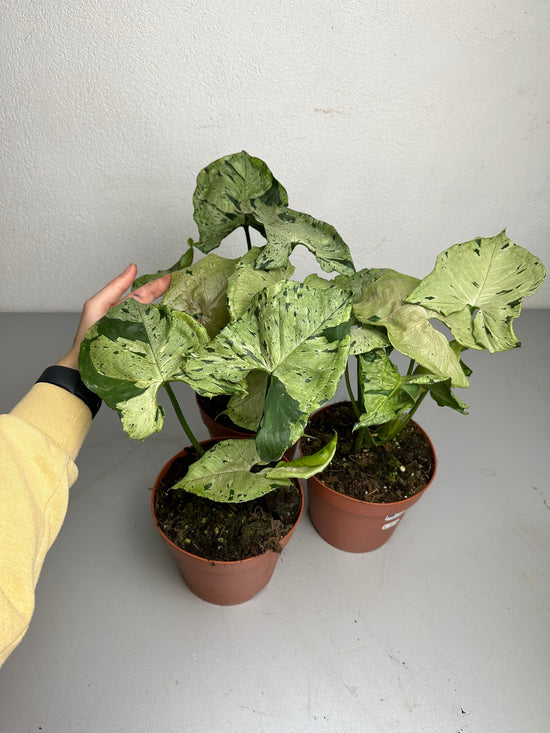More Syngonium care tips
The right soil
Use well-draining soil to allow your purple marigold's roots to develop healthily. A mixture of peat, sand, and perlite provides optimal conditions. A pot with drainage holes is essential to allow excess water to drain away, preventing waterlogging and root rot.
Repot Syngonium regularly
Syngonium care also includes regular repotting, ideally every one to two years, as soon as the roots have completely penetrated the pot or are growing out of the drainage hole at the bottom. This indicates that the plant no longer has enough space and needs fresh substrate and a larger pot. This not only gives the plant more space, but also fresh soil. This is especially important because old substrate loses structure and nutrients over time. Repotting promotes nutrient supply, supports strong roots, and contributes significantly to the long-term vitality of your Syngonium.
Nutrient supply for your purple tuber
For your plant to grow healthily and vigorously, it needs regular watering and a good supply of nutrients. Fertilization is therefore an important part of Syngonium care. It's best to use a balanced liquid fertilizer containing nitrogen, phosphorus, and potassium. During the growth phase, from spring to fall, fertilizing every two to four weeks is sufficient. This will keep your purple iris vital, develop strong leaves, and thrive in the long term.
Simulate the humidity of the natural habitat
Syngoniums originate from tropical regions and appreciate high humidity. Especially in winter, when the air is dry from heating, daily misting or setting up a humidifier can help recreate a humid environment for your Syngonium. Alternatively, you can place a bowl of water next to the plant or place it on a tray filled with expanded clay.
Prevent health problems and pests
Even with good care, your Syngonium can be affected by pests or diseases. Check the leaves and substrate regularly to detect any changes early. Yellow leaves often indicate waterlogging or a lack of light, while brown leaves indicate dry air, sunburn, or pests. Curled leaves can also be a warning sign. Remove affected parts of the plant and apply a suitable pesticide if necessary. Prevention is key: Avoid waterlogging, ensure good air circulation, and ensure adequate humidity and a stable location.
Pruning & shaping
Occasional pruning not only helps keep your Syngonium compact but also encourages new shoots to grow. Simply remove overly long or unevenly growing vines with clean, disinfected shears. For climbing varieties, you can also use targeted climbing aids or trellises to encourage a decorative shape for your Syngonium.
FAQ on Syngonium care
Are syngoniums suitable for beginners?
Yes, syngoniums are well-suited for beginners because they're relatively easy to care for. With a suitable location, regular watering, and the right soil, the plant can be kept healthy.
Where is the best Syngonium location?
The best location for your Syngonium is a bright spot with indirect light. Place your purple plant near an east- or west-facing window that doesn't receive direct midday sun. Alternatively, place it behind a light curtain to gently filter the light.
Are there any special features in Syngonium care for variegated species?
Yes, variegated Syngonium species require more light than green varieties because their lighter leaf areas contain less chlorophyll. A bright location out of direct sunlight is ideal for preserving the beautiful pattern. Too little light can cause the variegation to fade. Otherwise, Syngonium care is largely unchanged.
Does a Syngonium need a trellis?
Many syngoniums develop climbing shoots over time. A trellis can be helpful if you want to train the plant upwards.
Syngonium (Purple Tulip) for sale
-
Syngonium Redspot Tricolour
 Syngonium Redspot Tricolour
Syngonium Redspot Tricolour- Regular price
-
€20,00 - Regular price
-
- Sale price
-
€20,00
-
Syngonium Aurea Variegata
 Syngonium Aurea Variegata
Syngonium Aurea Variegata- Regular price
-
€29,00 - Regular price
-
- Sale price
-
€29,00
-
Syngonium Milk Confetti
 Syngonium Milk Confetti
Syngonium Milk Confetti- Regular price
-
€9,99 - Regular price
-
€14,99 - Sale price
-
€9,99
-
Syngonium Green Splash Gray Ghost
 Syngonium Green Splash Gray Ghost
Syngonium Green Splash Gray Ghost- Regular price
-
€29,00 - Regular price
-
- Sale price
-
€29,00
-
Syngonium Aurea Cutting
 Syngonium Aurea Cutting
Syngonium Aurea Cutting- Regular price
-
€19,00 - Regular price
-
- Sale price
-
€19,00
-
Syngonium Albo Variegata on Mosstab
 Syngonium Albo Variegata on Mosstab
Syngonium Albo Variegata on Mosstab- Regular price
-
€45,00 - Regular price
-
- Sale price
-
€45,00
-
Syngonium Albo Variegata
 Syngonium Albo Variegata
Syngonium Albo Variegata- Regular price
-
€35,00 - Regular price
-
- Sale price
-
€35,00










